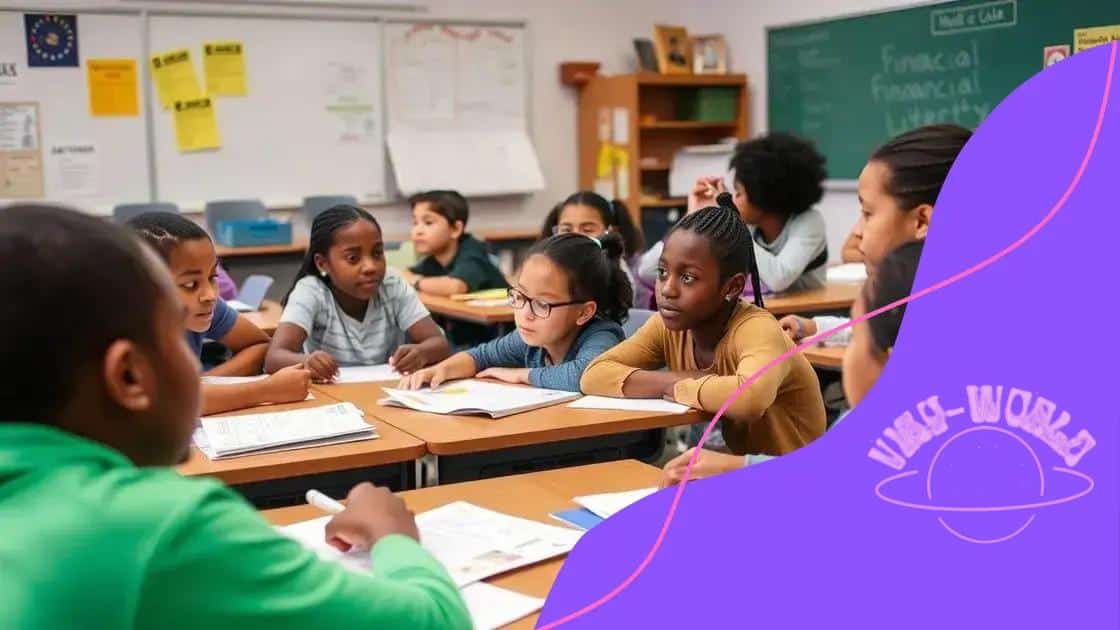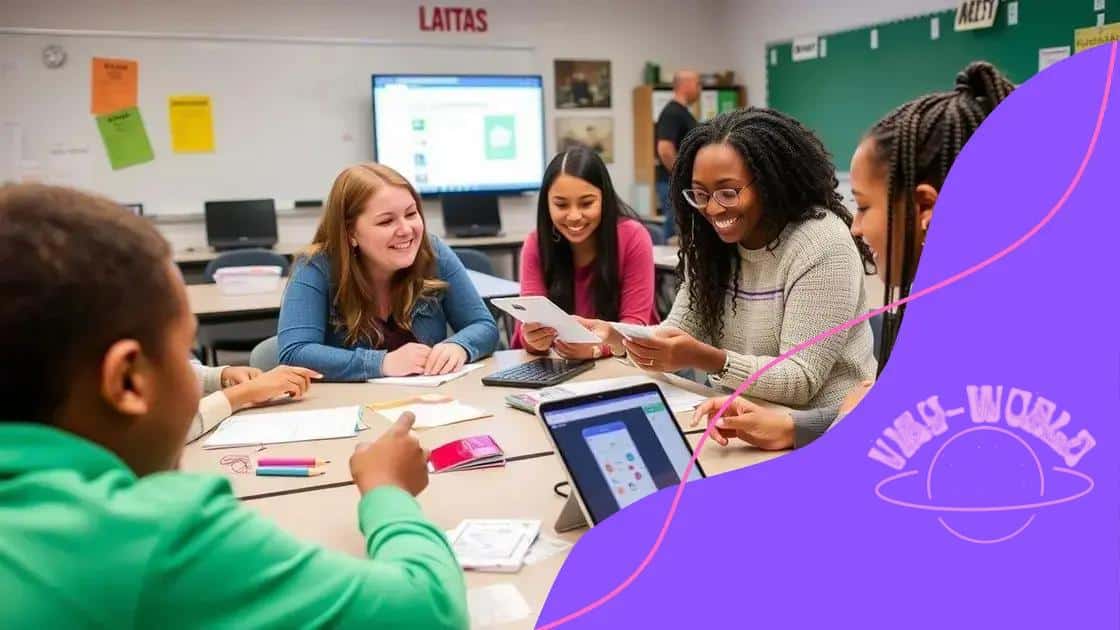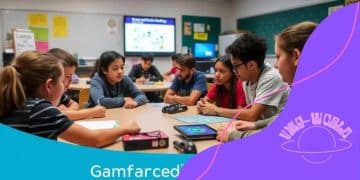Financial literacy curriculum development: a guide to success

Financial literacy curriculum development focuses on equipping students with essential skills to manage money effectively through engaging teaching strategies, practical assessments, and community involvement.
Financial literacy curriculum development is crucial for equipping students with the skills they need to navigate their financial futures. Have you ever wondered how well-prepared our young people are for managing money? This article dives into what makes a successful program.
Understanding financial literacy basics
Understanding financial literacy basics is essential for anyone looking to manage money wisely. It encompasses the skills needed to make informed financial decisions. With increased awareness, we can help individuals of all ages become more financially savvy.
What is Financial Literacy?
Financial literacy refers to the ability to understand and effectively use various financial skills. It includes understanding how to budget, save, invest, and manage debt. For many, these skills can significantly impact their quality of life.
Key Components
Here are some crucial elements that contribute to financial literacy:
- Budgeting: Knowing how to track income and expenses.
- Savings: Understanding the importance of setting aside money for emergencies.
- Investing: Learning how to grow wealth over time through various investment vehicles.
- Debt Management: Grasping how to manage loans and credit without falling into financial trouble.
By mastering these components, individuals can achieve a healthier financial future. The ability to budget can lead to more effective spending and savings habits. This foundation is vital for preventing debt and fostering long-term wealth.
Why It Matters
Financial literacy is not just about numbers; it’s about empowerment. When people understand their finances, they feel more confident in their decisions. This confidence can translate into better bargaining power when applying for loans or purchasing homes.
Moreover, schools that focus on teaching financial literacy help prepare students for real-world challenges. By equipping young minds with these essential skills, we pave the way for a financially informed generation.
Key components of an effective curriculum
To develop an effective financial literacy curriculum, it’s vital to understand its key components. These elements set the foundation for teaching practical finance skills. With the right framework, students can gain confidence in managing their finances.
Core Components
Here are some essential components to include in an effective curriculum:
- Goal Setting: Teach students how to set realistic and achievable financial goals.
- Budgeting Skills: Include lessons on creating and maintaining a budget to help manage income and expenses.
- Saving and Investing: Educate students on the importance of saving for emergencies and investing for long-term growth.
- Understanding Credit: Cover how credit works, the importance of credit scores, and responsible borrowing.
Incorporating these components not only provides knowledge but also instills confidence in financial decision-making. For example, lessons on budgeting can empower students to track their spending and identify savings opportunities. This hands-on approach helps them connect theoretical concepts to real-life applications.
Engagement Strategies
Engaging students is crucial for retention. Utilizing interactive activities such as simulations and group projects can enhance learning. Furthermore, incorporating technology through apps or online platforms brightens participation. This allows students to practice their skills in real-time and enjoy the learning process.
Assessments also play a significant role in measuring progress. Applying various forms such as quizzes, group discussions, and projects enables educators to provide useful feedback. Maintaining a focus on real-world scenarios ensures that students can relate what they learn to their daily lives, making the experience more valuable.
Practical teaching strategies for educators

Practical teaching strategies are vital for educators aiming to deliver an effective financial literacy curriculum. These approaches not only enhance learning experiences but also help students grasp essential concepts better. Engaging methods can spark interest and promote understanding of financial topics.
Interactive Learning
Incorporating interactive activities is a fantastic way to capture students’ attention. Games, simulations, and role-playing scenarios make the learning process enjoyable. For example, organizing a mock stock market game can provide real-world insights into investment strategies.
- Group Discussions: Encourage students to share their views on financial topics, promoting collaborative learning.
- Hands-On Projects: Have students create their own budgets or savings plans to apply learned concepts.
- Case Studies: Use real-life financial situations for analysis, helping students identify best practices.
By implementing these activities, educators foster an environment where students can learn practically. Moreover, students are likely to retain information better when they can relate to the scenarios presented.
Utilizing Technology
Technology plays a significant role in modern education. Utilizing apps and online resources can enhance learning experiences. Various platforms offer engaging lessons and tools tailored for financial literacy. For instance, budgeting apps can teach students how to manage their finances effectively.
Integrating technology into lessons keeps students engaged and allows for personalized learning. Whether it’s through online quizzes or financial calculators, using these tools helps students understand complex topics more easily. Ultimately, embracing technology can lead to a more robust understanding of financial literacy.
Assessing financial literacy skills
Assessing financial literacy skills is crucial in understanding how well students are grasping important financial concepts. Effective evaluation helps educators identify strengths and weaknesses in their students’ knowledge. This feedback allows for adjustments in teaching methods to enhance learning outcomes.
Importance of Assessment
By evaluating financial literacy, educators can ensure that students gain the skills needed to make informed decisions. Regular assessments can highlight areas where students excel and those that need more attention. When students realize their progress, they often feel more motivated to engage with the material.
- Formative Assessments: Use quizzes and informal assessments during lessons to gauge understanding.
- Summative Assessments: Implement tests at the end of units to measure overall comprehension.
- Project-Based Assessments: Encourage students to create budgets or financial plans that reflect their learning.
Utilizing a variety of assessment methods keeps the process engaging and informative. As students encounter different formats, they can adapt their study strategies accordingly. For example, a project-based assessment may encourage teamwork and practical application, providing depth to their learning experience.
Feedback and Improvement
Constructive feedback is essential after assessments. Providing insights on strengths and areas for growth helps students understand their performance. This feedback can come in many forms, such as one-on-one meetings, written notes, or group discussions.
Also, it is critical to create a supportive environment where students feel safe to ask questions. By encouraging open dialogue, students can clarify their misunderstandings and improve their skills. Ultimately, assessing and providing feedback not only tracks progress but also promotes a culture of continuous improvement.
Resources for enhancing student engagement
Resources for enhancing student engagement in a financial literacy curriculum can transform the learning experience. When students are actively involved, they are more likely to retain information and apply what they have learned in real-life situations. Various tools and materials can make learning about finance exciting and relevant.
Interactive Tools
Incorporating interactive tools is one way to boost engagement. Online platforms and applications can provide students with hands-on experiences. For example, budgeting apps allow students to practice managing money in a simulated environment.
- Simulation Games: These games mimic real financial situations, helping students learn by doing.
- Online Quizzes: Create fun quizzes that test knowledge while making learning competitive and engaging.
- Video Tutorials: Use videos that explain complex concepts in simple terms, making information accessible.
These resources can turn learning into an enjoyable experience. Encouraging students to work in groups on interactive tasks fosters collaboration. When students work together, they learn from each other and develop social skills alongside financial knowledge.
Community Involvement
In addition to technology, community involvement can enhance engagement. Inviting local financial professionals to speak can provide real-world insights. Students may find inspiration from guest speakers who share their own experiences in finance.
Field trips to banks or investment firms give students a behind-the-scenes look at how financial institutions operate. These experiences bridge the gap between theory and practice, making abstract concepts more tangible. By connecting classroom learning to the community, students can see the relevance of financial literacy in their lives.
The conclusion emphasizes the importance of a comprehensive approach to financial literacy education. By incorporating engaging resources, practical strategies, and assessment methods, educators can create a dynamic learning environment. Encouraging student participation and involving community resources can help students grasp essential concepts. As they learn these skills, they become more prepared for making informed financial decisions in their lives.
FAQ – Questions about Financial Literacy Curriculum Development
Why is financial literacy important for students?
Financial literacy helps students make informed financial decisions, preparing them for real-life financial challenges.
What are effective strategies for engaging students in financial literacy?
Using interactive tools, simulations, and group discussions can make learning about finance fun and relatable.
How can assessments improve financial literacy education?
Assessments provide insights into student understanding and progress, allowing educators to tailor their teaching methods effectively.
What role does community involvement play in financial literacy programs?
Community involvement, through guest speakers and real-world experiences, enriches the curriculum and connects classroom learning to practical applications.





